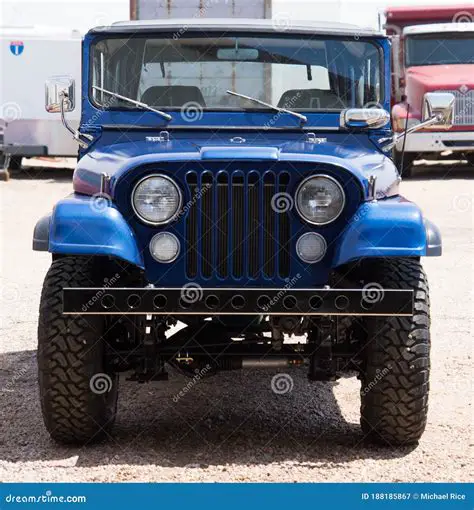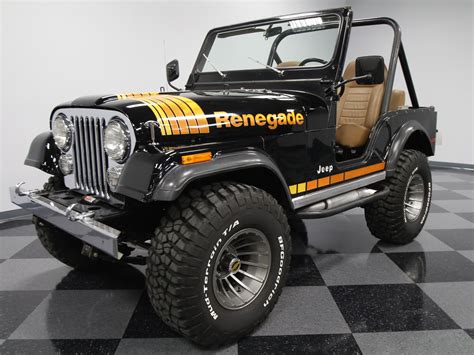Jeep Cj5 problems

The Jeep CJ models are a series and a range of small, open-bodied off-road vehicles and compact pickup trucks, built and sold by several successive incarnations of the Jeep automobile marque from 1945 through 1986. The 1945 Willys "Universal Jeep" was the world's first mass-produced civilian four-wheel drive car.
In 1944, Willys-Overland, the primary manufacturer of the World War II military Jeep, built the first prototypes for a commercial version – the CJ, short for "civilian Jeep". The design was a direct evolution from the war jeep, but the most obvious change was adding a tailgate, and relocating the spare wheel to the side. Also, besides adding basic civilian amenities and options and legally-compliant lighting, the CJ required a sturdier drivetrain than the war jeep, because the targeted rural buyers would work the vehicles hard and expect years of durability, instead of mere weeks as during WWII.
From then on, all CJ Jeeps consistently had a separate body and frame, rigid live axles with leaf springs both front and rear, a tapering nose design with flared fenders, and a fold-flat windshield, and could be driven without doors. Also, with few exceptions, they had part-time four-wheel drive systems, with the choice of high and low gearing, and open bodies with removable hard or soft tops. A few stand-out changes during 42 model years were the introductions of round-fendered vs. flat-fendered bodies (1955 CJ-5), straight-6 and V8-engines, automatic gearboxes, and different 4-wheel drive systems. The 1976 CJ-7 stretched the wheelbase by 10 inches (25 cm), and made doors and a removable hardtop common items.
After remaining in production through a range of model numbers, and several corporate parents, the Jeep CJ line was officially ended after 1986. More than 1.5 million CJ Jeeps were built, having continued the same basic body style for 45 years since the Jeep first appeared. Widely regarded as "America's workhorse", the CJs have been described as "probably the most successful utility vehicle ever made." American Motors VP Joseph E. Cappy said the end of "CJ production will signal an end of a very important era in Jeep history." In 1987, the Jeep CJ-7 was replaced by the first-generation Jeep Wrangler. Looking very similar and riding on the same wheelbase as the CJ-7, it carried over some important components, including its use of leaf springs.
The similar model the DJ "Dispatcher" was introduced in 1956 as a two-wheel drive version with open, fabric, or a closed steel body in both left- and right-hand drives for hotel, resort, police, and later United States Postal Service markets.

Social links
Common Jeep Cj5 problems
The Jeep CJ5 is a classic off-road vehicle that has been popular for many years. However, like any vehicle, it has its own set of common problems that owners have reported.
One of the most significant issues with the Jeep CJ5 is its tendency to roll over, even at slower speeds. This is due to the vehicle's high center of gravity and narrow track width, which can make it unstable in certain driving conditions. Drivers can take precautions to avoid rollover accidents, such as driving more slowly and carefully, particularly in corners.
Another issue with the Jeep CJ5 is its suspension system, which can become upset and cause the car to "nope out of existence" if it gets too upset. This can happen on certain tracks, and it may be necessary to adjust the suspension settings or use different tracks to avoid this issue.
The solid front axle and steering design of the Jeep CJ5 can also cause problems, particularly for drivers using gamepads. The steering will pull to the right at all times and swerve heavily over bumps, making it difficult to control the vehicle. This is a design issue that cannot be easily fixed.
The Jeep CJ5's engine and transmission can also cause problems. The 5-liter AMC V8 engine, which was introduced in 1976, produces only 150 horsepower and is attached to a 3-speed manual transmission with very long final gears. This means that the vehicle is not particularly powerful or fast, and it may struggle to reach high speeds.
Finally, the Jeep CJ5's safety features are limited, particularly when it comes to rollover accidents. While adding a front sway bar can help enhance the vehicle's stability, it may not be enough to prevent rollover accidents entirely. Drivers who are concerned about safety may want to consider other vehicles that offer more advanced safety features.
In summary, the Jeep CJ5 is a classic off-road vehicle that has many fans, but it also has several common problems that owners should be aware of. These include rollover accidents, suspension issues, steering problems, engine and transmission limitations, and safety concerns. By understanding these issues, drivers can take steps to avoid them and enjoy their Jeep CJ5 to the fullest.

What's better, CJ5 or CJ7?
the difference between a CJ5 and a CJ7 is CJ2! I like the looks of the CJ5 as much as the CJ7, but the '7 has better road manners and a little more room. I also really like hard tops, and it's pretty hard to find one for a '5. For those reasons both of my jeeps have been CJ7's.
What engines came in a CJ5?
CJ-5
- 134 cu in (2.2 L) Willys Hurricane I4.
- 192 cu in (3.1 L) Perkins 4.192 I4 diesel.
- 225 cu in (3.7 L) Dauntless V6.
- 151 cu in (2.5 L) Iron Duke I4.
- 232 cu in (3.8 L) AMC I6.
- 258 cu in (4.2 L) AMC I6.
- 304 cu in (5.0 L) AMC V8.
What is the fuel average of CJ5?
Jeep CJ 5 Specifications
| Price | PKR 9.6 - 15.5 lacs |
|---|---|
| Fuel Type | Petrol |
| Mileage | 7 - 10 KM/L |
| Fuel Tank Capacity | 40 L |
| Seating Capacity | 4 Persons |
What year did the CJ5 get longer?
But what is clear is that in 1972, the wheelbase of the CJ-5 jumped to 84 inches and the length to 142.1 inches, while the CJ-6 increased to 104 and 162.1 inches, respectively. Most of the increase came from the stretching of the front section, hence the name "long-nose" CJ-5 for the later years.
Percentage distribution of complaints by Jeep Cj5 years
We have researched Jeep problems and analysed all the complaints filed against Jeep Cj5 cars and compiled the top 2 most problematic Jeep Cj5 model years:
Below you can see the percentage distribution of known problems by Jeep Cj5 model years.
Distribution of the number of complaints by Jeep Cj5 years
We've also compiled a chart for you with the number of complaints about Volkswagen Jetta cars of certain model years:
Jeep Cj5 car problems categorized by type of issue
After analysing all complaints related to Jeep Cj5 , it was concluded that the most common issues with these cars are:
- Power train problems
- Steering problems
The graph below shows statistics for all Jeep Cj5 vehicle components and the number of complaints received.
The NHTSA has received 2 complaints about various vehicle components related to the Jeep Cj5 . Below are the 25 most recent complaints reported for Jeep Cj5 vehicles.
List of Jeep Cj5 complaints
Jeep Cj5 1979
- Date Of Incident: 2010-06-07
- Date Complaint: 2010-06-10
- Components: POWER TRAIN
- Summary: TL*THE CONTACTS OWN A 1979 JEEP CJ5. THE CONTACT STATED THAT WHILE DRIVING 30MPH HE SHIFTED INTO SECOND GEAR AND THE VEHICLE MADE A LOUD NOISE. WHEN HE SHIFTED INTO THIRD GEAR THE ENGINE SHUT OFF. A FEW MINUTES LATER, THE CONTACT WAS ABLE TO RESTART THE VEHICLE. HE NOTICED THAT TRANSMISSION FLUID WAS LEAKING FROM THE VEHICLE. THE CHRYSLER DEALER REFERRED HIM TO A JEEP DEALER WHO CONFIRMED THAT NHTSA CAMPAIGN 79V070000, POWER TRAIN, MANUAL TRANSMISSION RECALL WAS RELATED TO THE FAILURE; HOWEVER, THE JEEP DEALER REFUSED TO REPAIR THE VEHICLE SINCE THERE WAS A 10 YEAR SUNSET CLAUSE. THE VEHICLE HAD NOT BEEN REPAIRED. THE VIN WAS NOT AVAILABLE. THE FAILURE AND CURRENT MILEAGES WERE 50,000.
Jeep Cj5 1978
- Date Of Incident: 2007-03-17
- Date Complaint: 2007-05-02
- Components: STEERING
- Summary: TL* THE CONTACT OWNS A 1978 JEEP CJ5. THE CURRENT MILEAGE WAS 200, REBUILT ENGINE, AND THE FAILURE MILEAGE WAS UNKNOWN. THE STEERING COLUMN WAS VERY LOOSE WHERE THE COLUMN JOINED THE SHAFT UNDERNEATH THE HOOD. WHEN HITTING BUMPS OR UNEVEN PAVEMENT ONE COULD HEAR THE STEERING COLUMN RATTLING. THE STEERING COLUMN GOT WORSE WITH TIME. *AK
Recalls Jeep Cj5
The National Highway Traffic Safety Administration (NHTSA) has issued 4 recalls for different components of the Jeep Cj5.You can explore the year of the Volkswagen Jetta you are interested in by selecting it from the list.
- Model: Jeep Cj5 1979
- Report Received Date: 1979-03-14
- Manufacturer: CHRYSLER CORPORATION
- Components: POWER TRAIN:MANUAL TRANSMISSION
- Summary: CERTAIN VEHICLES MAY HAVE AN INCORRECT GASKET BETWEEN THE TRANSMISSION AND THE TRANSFER CASE. AN INCORRECT GASKET MAY INTERFERE WITH THE NORMAL FLOW OF LUBRICANT. THIS CONDITION COULD CAUSE THE TRANSMISSION TO BECOME DAMAGED AND INOPERATIVE.
- Remedy: THE GASKET BETWEEN THE TRANSMISSION AND THE TRANSFER CASE WILL BE REPLACED, IF NECESSARY.
- Model: Jeep Cj5 1979
- Report Received Date: 1978-11-06
- Manufacturer: CHRYSLER CORPORATION
- Components: STEERING:LINKAGES:ROD:RELAY:CONNECTING
- Summary: THE CLAMP BOLTS ON THE ADJUSTER TUBE THAT FASTENS THE CONNECTING ROD TO THE PITMAN ARM END ASSEMBLY MAY BE LOOSE. THESE LOOSE BOLTS COULD CAUSE SHIFTING OF THE STEERING WHEEL POSITION, RELATIVE TO THE STRAIGHT-AHEAD-FRONT WHEEL POSITION, AND LOSS OF STEERING.
- Remedy: THE DEALER WILL TIGHTEN THE BOLTS WHERE NECESSARY, AND CHECK AND CORRECT THE STEERING WHEEL ALIGNMENT FREE OF CHARGE.
- Model: Jeep Cj5 1978
- Report Received Date: 1978-03-09
- Manufacturer: CHRYSLER CORPORATION
- Components: STEERING: STEERING WHEEL/HANDLE BAR
- Summary: THE COUPLING WHICH ATTACHES THE INTERMEDIATE STEERING SHAFT TO THE STEERING GEAR MAY HAVE OVERSIZED SERRATIONS WHICH COULD PREVENT THE COUPLING FROM BEING PROPERLY TIGHTENED IN THE STEERING GEAR SHAFT WHEN THE STEERING WHEEL IS TURNED. THIS MAY ALSO CAUSE FREE PLAY IN THE STEERING WHEEL.
- Remedy: THE INVOLVED VEHICLES WILL HAVE THE COUPLINGS REPLACED.
- Model: Jeep Cj5 1978
- Report Received Date: 1978-02-17
- Manufacturer: CHRYSLER CORPORATION
- Components: POWER TRAIN:MANUAL TRANSMISSION
- Summary: THE INVOLVED VEHICLES MAY HAVE BEEN BUILT WITH THE TRANSMISSION ADAPTER PLATE SEAL IMPROPERLY SEATED. THIS CONDITION COULD ALLOW A GRADUAL TRANSFER OF LUBRICANT FROM THE TRANSMISSION TO THE TRANSFER CASE.
- Remedy: THE DEALER WILL INSPECT THE LUBRICANT LEVELS ON THE INVOLVED VEHICLES AND, WHERE NECESSARY, REPLACE THE REAR OIL SEALS.
Are you having problems with your Jeep Cj5?




